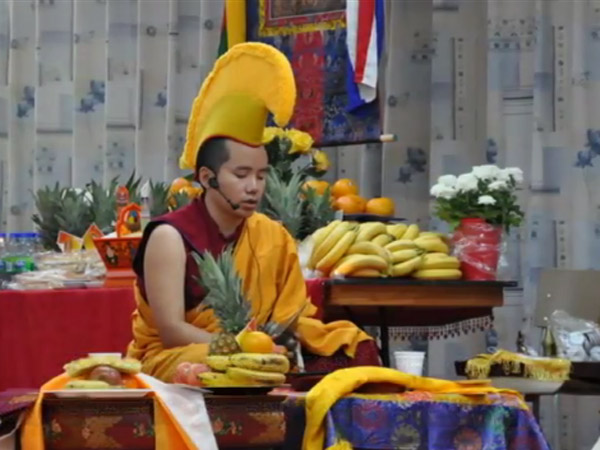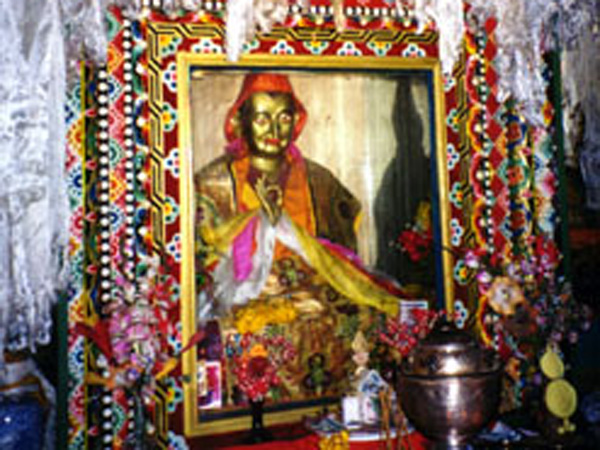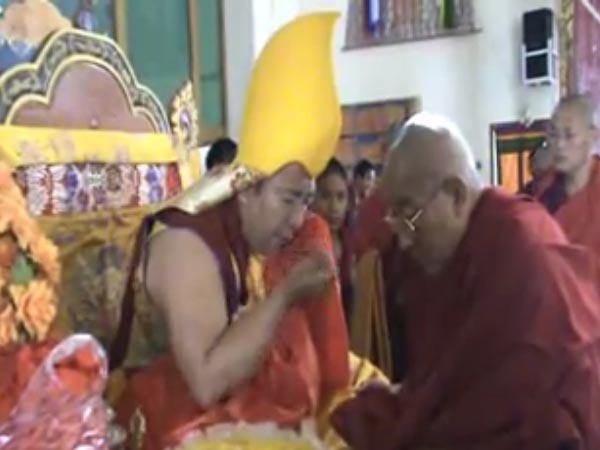DHARMA READINGS
| THE TULKU SYSTEM IS CRUCIAL FOR THE LINEAGE TO ENDURE | | Print | |
 Reincarnation is an important fundamental belief in Buddhism just as karma is a driving factor. Probably the best authority to reinforce the existence of reincarnation is the Buddha himself, as he developed retro-cognitive powers and recalled all of his past lives. Just like all sentient beings, the Buddha, born as Prince Siddharta, had lived as other persons/beings in the past and had returned to continue his journey to enlightenment. Until one reaches a certain level of spiritual attainment, the circumstances of one’s incarnation happen by the compulsive force of one’s karma. Readers' Comments
In other words, it is outside one’s control and so, the ultimate objective in Buddhism is to reach enlightenment, which put simply, is a state outside the control of karma. Therefore after a certain level of training under the Buddhist path, one begins to gain control over where one is reincarnated. In these situations, instead of being driven by karma, one’s incarnation is determined by a conscious aspiration to be reborn at a particular location and time, and to a particular family and into a particular situation – all determined based on the objective to be of the best benefit in the name of compassion. Such beings are known as Tulkus, who have attained the ability to re-enter the world at will, ready to continue their previous lifetimes’ work of benefiting others. While there are many classes of Tulkus, the highest ones are unmistakably emanations of Buddhas or manifestations of enlightenment on the physical plane. The Tibetan word “Tulku” itself is a translation from the Sanskrit word “Nirmanakaya”, which refers to one of the three bodies of the Buddha. Nirmanakaya is the emanation body of the Buddha (the other two are the “Dharmakaya” or Truth body and “Sambhogakaya” or Bliss/Enjoyment body). In other words, in Buddhism, sometimes the Buddhas themselves decide to take incarnation in the form of a human being in order to benefit mankind. H.H. Trijang Choktrul Rinpoche is one such high Tulku, being the undisputed reincarnation of H.H. Kyabje Trijang Rinpoche, who is respectfully considered a Buddha. Trijang Rinpoche has taken incarnation many times before as great Buddhist masters, one of whom was none other than Atisha. Recognition of the incarnations of these attained masters as “Tulkus” is peculiar to Tibetan Buddhism. Within Tibetan Buddhism, also known as the Vajrayana path, the Tulku system contributes directly to the preservation of the essence and purity of Buddhism. This is based on the logic that an attained being reincarnates as a Tulku to continue the dissemination of knowledge and achievement of attainments he accomplished from pure practice in his previous lives, which is retained in his mindstream. And yet, there are those who advocate for the cessation of Tulkus to be recognized. Despite the benefits of and logic behind the Tulku system that has proven itself for centuries, some have out rightly rejected it. The New Kadampa Tradition (NKT), under its founder, Geshe Kelsang Gyatso’s instruction, is one such organization, that views the process of recognizing and enthroning Tulkus to be an outdated Tibetan tradition that has outlived its purpose. Whilst clearly the NKT is undoubtedly a highly reputable Dharma group that has firmly established itself as a true champion of the Buddha’s teachings and whilst it is not for anyone to oppose NKT’s policies formulated under the wise guidance of Geshe Kelsang Gyatso, we do invite the NKT to provide some insights into the reasons for their discard of the Tulku system so that readers may have a broader perspective of the issue. The reason we are engaging the NKT is a friendly discussion on this subject is due in part to a particular act by Geshe Kelsang Gyatso himself. In stark contrast to the NKT’s policy, Geshe Kelsang Gyatso himself demonstrates his acceptance of the process of recognizing reincarnated beings, which is at the heart of the Tulku system, and even mentions it in his book, Introduction to Buddhism. On pages 22 and 23 of the book, it is clearly stated that he recognized the reincarnation of his own mother. If Geshe Kelsang Gyatso accepts reincarnation to exist and recognizes that his own mother, who was a very virtuous lady and who did a lot of Mani mantras, can be reincarnated, then, why can’t incarnations of other beings be recognized, especially highly attained masters? From Geshe Kelsang Gyatso’s own testimony we know for sure that (i) reincarnation does exist (ii) there are methods to recognize incarnations and (iii) there are those who are trained and have the ability to recognize incarnations. So, why is the Tulku system deemed to be obsolete when it is in fact based on the same factors upon which Geshe Kelsang Gyatso recognized the incarnation of his mother? 
Venerable Geshe Kelsang Gyatso, Founder and Spiritual Director of the New Kadampa Tradition Some who advocate the abolition of the Tulku system claim that the process of recognition of Tulkus can be tainted and made an instrument of abuse. However, it should be noted that the mere recognition of a child as an incarnation of a high lama and the ensuing ceremony to install the child in his previous incarnation’s position, is not the definition of the Tulku system. The child still needs to be trained and observed and ultimately, rise to display signs of his previous life’s attainments as any authentic incarnation naturally would. The Tulku is not exempted from having to prove himself and the higher up the hierarchy he occupied in his previous life, the higher the expectation he has to live up to and the more difficult it is to fake such qualities. Ultimately, the “test” of a Tulku is the qualities of wisdom and compassion he shows and the skills and aptitude he exhibits very early on in his life and continues to develop as his monastic education and training progresses. The benefit of the Tulku system is that it allows reincarnated master to undergo the necessary process that would bring to being their knowledge, wisdom and attainments acquired in their previous lives in the shortest time possible, so that many people can benefit from them quickly, instead of waiting for years or decades for Dharma masters to be trained and qualified. Enlightenment is after all not a subject that is easily grasped and mastered in a single lifetime. The rejection of the Tulku system is also most unfortunate because it would mean that one of the most efficacious ways for high lamas and Bodhisattvas to take rebirth and continue their previous life’s mission, and a system that has undeniably helped to preserve and prolong the purity of the Buddha’s teachings, are denied. There are also other unfortunate repercussions. In rejecting the Tulku system, the NKT, for example, does not allow itself to recognize Trijang Choktrul Rinpoche as the reincarnation of Geshe Kelsang Gyatso’s own guru, Kyabje Trijang Rinpoche. This is an incredible shame, given how close Trijang Rinpoche was to Geshe Kelsang Gyatso as his student. 
NKT’s Manjushri Meditation Centre, UK Therefore, I consider the Tulku system to be not only very relevant but even crucial in this day and age when Buddhism is degenerating. As long as Tulkus are recognized by elite masters and therefore indisputable, the benefits to Dharma students by continuing an unbroken lineage are immeasurable. Just because NKT does not recognize the Tulku system does not render this ancient Tulku system obsolete. Like the concept of karma, the recognition of the controlled rebirth of a high master or Bodhisattva for the purpose of benefitting sentient beings, does not require anyone’s belief or consent. E.L. Gosch
DorjeShugden.com accepts articles and materials from readers and external contributors who wish to contribute to our site. Publication of any submissions is at the discretion of DorjeShugden.com and we reserve the right to republish any submissions on this website and associated materials. DorjeShugden.com does not necessarily endorse the views of our contributors.
|
OTHER DHARMA READINGS
- A GUIDE TO SPIRITUAL PRACTICE
- DHARMA DEMYSTIFIED: NAGARJUNA, THE FOUNDER OF THE MAHAYANA TRADITION
- DORJE SHUGDEN ON BLACK HORSE
- WHY MANJUSHRI MATTERS
- DHARMA DEMYSTIFIED: THE ENTHRONEMENT OF DORJE SHUGDEN










